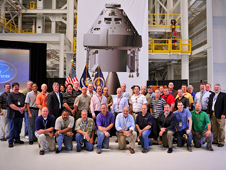The NASA team at the Michoud Assembly Facility (MAF) in New Orleans has been putting the finishing touches on the first space-bound Orion capsule.
NASA’s Orion Program took the opportunity to recognize the outstanding work done by the Orion team in meeting this major milestone for NASA’s Human Exploration Program. The program hosted an employee recognition event for the MAF team members where Orion Program Manager Mark Geyer was on hand to give the awards and offer his personal thanks for the dedication and commitment of the team working to build the next generation of American spacecraft.
In addition to the awards, Geyer gave an overview of Orion progress and the work underway to prepare for NASA’s Exploration Flight Test-1 (EFT-1), scheduled for 2014. Space Launch System (SLS) Program Manager Todd May, also gave an update on the SLS, NASA’s next generation heavy lift rocket that will launch Orion to deep space destinations. Cleon Lacefield, Orion Program Manager for Lockheed Martin was also on hand to thank employees for their accomplishments. The MAF team completed the Orion pathfinder weld, which is essentially a practice operation, in preparation for the final Orion weld, scheduled to take place June 20. Once this is completed, the team will do final inspections before carefully preparing the capsule for its move to the Kennedy Space Center Operations and Checkout Facility at the end of June for final assembly and checkout.
The EFT-1 flight will take Orion to an altitude of more than 3,600 miles, more than 15 times farther away from Earth than the International Space Station. Orion will return home at a speed of 25,000 miles, almost 5,000 miles per hour faster than any human spacecraft. It will mimic the return conditions that astronauts experience as they come home from voyages beyond low Earth orbit. As Orion reenters the atmosphere, it will endure temperatures up to 4,000 degrees F., higher than any human spacecraft since astronauts returned from the Moon.
The first Orion spaceflight vehicle will fly atop a Delta IV Heavy, a rocket operated by United Launch Alliance. While this launch vehicle will provide sufficient lift for the EFT-1 flight plan, the SLS will be needed for the vast distances of future exploration missions.
Following EFT-1, the first integrated flight test will launch an uncrewed Orion on the SLS in 2017. That test will put the entire integrated exploration system through its paces. The Orion Spacecraft will have the capability to carry astronauts to the moon, asteroids, Mars and other deep space destinations.
The NASA Orion/Industry team has contracts with hundreds of small and disadvantaged business suppliers across the United States. There are about 3,000 people who work on the Orion program nationwide, including contractors, civil servants, subcontractors, suppliers and small business owners.
3 min read
























